REMEMBERING RICHARD COLE ONE YEAR GONE/LZ NEWS/CHRISTINE McVIE RIP/THEY COULD NOT CONTINUE AS THEY WERE 42 YEARS GONE/CODA IT WAS 40 YEARS AGO/MOJO COLLECTORS LED ZEP SPECIAL/LIVE TIMES BOOK/ DL DIARY BLOG UPDATE
One year ago on December 2 2021 the legendary Led Zeppelin tour manager passed away.
Led Zeppelin tour manager and so much more.
Such a friend and support to Janet and I in recent challenging times – writer of the wonderful Foreword to the Evenings With Led Zeppelin book.
I had so many special conversations and times with him over many years –the last being when I visited him in October 2021. Even though his health was failing it was such an uplifting occasion as we talked about those Zep glory years – his pride for it all so evident right to the end.
He was of course aware of the rock’n’roll lifestyle they all led and regretful of some incidents that surrounded his role.
”There was and always will be only one Led Zeppelin’’ are the opening words he wrote in that Foreword…
There was and always will be only one Richard Cole and he is so sorely missed…he was truly one of the most extraordinary people I have ever had the fortune to know.
RIP dear Richard…
Here’s some personal thoughts of Richard one year on …
Over many years Richard was always been so supportive of my Led Zeppelin writings – in 2018 he contributed the most wonderful Foreword for the Evenings With Led Zeppelin book I wrote with Mike Tremaglio. Early in 2021 I interviewed him on the phone about the Zep Knebworth concerts for a feature I wrote for Rock Candy magazine. This would prove to be his final word on Zep in print.
His pioneering tour managing role with Led Zeppelin and before that with The Who and Yardbirds was a crucial element in Zep’s world conquering success. For within all the much documented sex drugs and rock’ n’roll he was an incredibly shrewd operator and a highly intelligent negotiator. With the maverick manager Peter Grant and the four members of Led Zeppelin he formed a formidable team – ‘’it was always six of everything’’ he once told me.
I met him on a fair few occasions in the Swan Song office in the late 1970s. The first time was when he came marching up the stairs, took one look at me sitting in the office and proclaimed ‘’Who’s that ‘effin ice cream! (abbreviated cockney rhyming slag =ice cream feezer (geezer).
I rather shakily introduced myself as a fan and writer of my own Zep magazine. Thankfully he soon warmed to my presence. Years later we often laughed about that rather frightening (for me) indignant first crossing of paths.
I also saw him in tour manager action first hand when he was ushering the band into place at Heathrow Airport on May 17 1977 prior to their flight to commence the second part of the massive US tour. His command of the task in hand was more than evident. How lucky I was to be there and witness that…
When Richard moved to Kensington in the early 2000s I made contact with him again and eventually met to conduct a lengthy interview for a US radio station. It was an illumining day and the first of many in his company. I think the fact that I came from the angle of how he got Zep from A to B on any given tour rather than all the usual stuff he was asked about, allowed me to gain his trust.
He loved telling those on the road stories and when it came to the Evenings With Led Zeppelin book he very graciously accepted my request to write the Foreword.
‘’Looking through this book brings it all back to me -city by city and gig to gig’’ he wrote. ‘’It’s like a virtual travelogue of 11 years of my life. 11 years of my life that seem barely imaginable now but 11 years I wouldn’t have missed for the world and what incredible times they were.’’
On May 17 1977 I made a journey to Heathrow Airport to see the members of Led Zeppelin gather as they prepared to fly out for the second leg of their mammoth US tour. It was of course incredibly exciting to see them all –and one thing I was able to see at close proximity was Richard’s sense of organisation. It was his job to ensure they got there and on time with minimum fuss –and he did it with such integrity and drive…
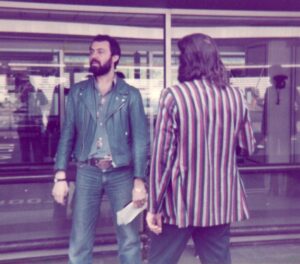
Here’s a rarely seen photo (courtesy of Russ Rees and Peter Jones) of Richard at Heathrow that afternoon with John Bonham just in front of him.
I showed Richard this on my last visit to see him on October 18 2021 and of course he was full of tales of this adventure.
Richard was immensely proud of his role within the success of Led Zeppelin – and his memory for those times was vivid right to the end. Often he would randomly ring me and dispute some minor detail in the book when it was in the work in progress stage and I of course always bowed to his superior knowledge – because he was there…
Much more than his role in the world of Led Zeppelin and his other management roles with the likes of The Quireboys, Richard was a loyal friend to many and away from the rock’n’roll mayhem, he was also a very sensitive soul – he was a tireless worker for AA, attending regular meetings to support others.
He was also aware of the affectionate and esteem he was held in within the Zep fan community and enjoyed the acclaim and rapport he had with the Richard Cole Appreciation Society Facebook group ably maintained by Sean Atkinson.
He was certainly a great friend to us here. Despite his own ongoing health issues he was always ringing to find out how Janet and I were – so sympathetic and supportive of my own mental health issues and Janet’s leg break problems.
During 2021 I have been aware of how poor his health was and on October 19 I went to visit him at his flat in Kensington.
Despite his obvious failing health he was in amazingly good spirits. There’s no doubt he knew his time was coming to an end and I was aware this was likely to be the last time I ever saw him. Failing health or not -it did not stop him lighting up a cigerette – the maverick to the last…
For a good couple of hours he relayed to me many a tale of being on the road, right back to his early touring days with The Who and The New Vaudeville Band – so many incredible stories and as ever relayed with much humour.
He told me that in 1974 when he had a bit of a brief falling out with Peter Grant he went off to work with Eric Clapton on his comeback tour. Now Richard was good friends with the Elvis Presley camp and Elvis himself – -having met him on more than one occasion. Eric made a request to visit Elvis and asked Richard to try and arrange it. Richard rang Elvis’ personal associate Jerry Shilling to ask if Elvis would have an audience with the pair. Word came back from the King ‘’ Look, I know who Richard Cole is but who’s this Eric Clapton guy?’’
Such was the reputation of Richard Cole – perhaps the most famous tour manager in the history of rock’n’roll. Like I said, his pride for it and his role within it all was always so evident – right to the very end.
Last October on that bright autumn morning in Kensington it was again uplifting and inspiring to be in his company for one what would prove to be the final time. As I was leaving I asked Richard if he would sign my copy of his Stairway To Heaven book that I brought along..
‘’To my dear friend Dave Lewis’’ he wrote.
‘’Thank you for your wonderful books and magazines over the years.
Best always, Richard – October 18 2021’’
I will treasure that for evermore…and how I miss his phone calls and discussions on the Zep touring years. How for instance, he got Zep from a gig at the Ohio University on May 18 1969 to performing at the Tyrone Theatre in Minneapolis the next day – his way. He was always a man of such insightful detail.
That he took me into his confidence and showed much interest in my work and showed such compassion to Janet and I, remains one of the truly blessed things that has happened in my life.
”There was and always will be only one Led Zeppelin’’ he wrote in the Foreword to the Evenings With Led Zeppelin book
‘’Whenever Led Zeppelin hit the stage it was telepathic. For the next two and a half hours there was no better place to be than where I was, stood right next to them on those stages. Watching, waiting and ready to do anything I could to help. They were simply fantastic and I’m immensely proud to have worked with them’’
Indeed there was and always will be only one Richard Cole…
An incredibly intelligent, warm, kind and generous man – he is so sorely missed.
RIP dear Richard…
Dave Lewis – December 1 2022
The sad passing of Richard Cole last December inspired a wealth of tributes including of course from Jimmy Page and Robert Plant.
I had a lot of feedback and comments at the time here’s a couple of the many tributes that were paid to the man who was the Led Zeppelin tour manager and so much more…
Phil Carlo roadie and road manager with Bad Company, Zep and Jimmy Page commented ”Richard was such a great help to me when I first started working with Zeppelin 50 years ago this month. He will be much missed”
Guy Griffin of The Quireboys who Richard worked with in the 90s said ”What an amazing man – he was like a father figure when he looked after me age 21 on tour in America with The Quireboys”
Richard Cole Obituaries:
On December 8 both the London Times and Telegraph ran extensive obituaries to Richard. I think Richard would have had a few choice expletives if he knew the Telegraph had mis -captioned the photo they used – it says Robert Plant with Richard Cole – it’s actually Roy Harper…
Chris Charlesworth did a very perceptive Richard Cole obituary on his always excellent Just Backdated blog – see link here:
https://justbackdated.blogspot.com/2021/12/richard-cole.html
Jimmy Page and Robert Plant paid tribute to him, with Page calling him “a brother and a friend to the end.” Plant visited Cole earlier this year, and wrote that he was “brave to the end.”
The Last Interview:
Here’s the last interview that Richard gave. He very kindly agreed to do this interview with me on the phone in early 2021. It’s his recollections of the Led Zeppelin Knebworth concerts in 1979. It was featured in the 2021 June/July issue of Rock Candy in a feature I wrote on Zep at Knebworth…
As their tour manager Richard Cole was the man who made sure Led Zeppelin got from point A to B, and as he reveals to Dave Lewis ‘’It was an unforgettable experience… there was always a special camaraderie and that was still all there at Knebworth.’’
Dave Lewis: Having not toured for two years, what was your reaction to Peter Grant’s decision to stage Zep’s comeback at Knebworth?
Richard Cole: I was very pleased that we were back working. The way it would work is that Peter Grant would discuss things with the band and he would inform me of the plans. Then it was up to me to logistically work it all out. I do remember going to discuss the Knebworth plans with Freddy Bannister at his home in Knightsbridge. Then I went to Knebworth house and met the Cobbold family who owned it. The first thing we did was look around the park to see where the stage would be best suited. I then liaised with Ian Knight who did the lighting production and Showco our PA company in Dallas.
DL: What logistical issues did you face in presenting what would be the band’s largest ever UK shows?
RC: Not many really, as we’d already had a lot of experience in running big shows with massive audiences – there had been a few of those on the last Zep US tour. The Showco PA came over and it was a fairly smooth set up as I remember. We tested all the gear and did two warm-ups in Copenhagen. The morale was very high and the rehearsals were great. We built the stage at Bray Studios, and it was one of the biggest they’d ever performed on. At the soundcheck on the Thursday, Robert, Bonzo, and the guys went out front to hear what the sound was like. That was when Jason took over on drums for a number.
Basically my job was to make sure everything fell into place and to do that there was a lot of preparation. I had to make sure they got on stage, played and then we left, although there was a bit more to it than that. I was talking to Metallica’s tour manager once and he told me their crew stretches to over a 100 people – we did Knebworth on something like 30.
DL: What are your memories of the shows?
RC: I knew they were on form and the audience reaction was incredible. You have to remember though that I was backwards and forwards all the time – I didn’t get to see a show all the way through or stand on the side of the stage for long. There was always other business to take care of. At the second Knebworth show it was down to me to pay Keith and Ronnie for their set – I paid it in cash from the day’s takings. It occurred to me when I attended their O2 reunion show for Ahmet Ertegun in 2007 that it was the first time I had ever sat and watched an entire Zep show. Usually I was running around making sure everything was going to plan.
DL: Do you think Zep had a future in the 1980s?
RC: Yes I do. Knebworth was never planned as some sort of grand farewell. Looking back, there were countries they missed out on such as Brazil – though that was a bit dangerous at the time, with one band out there having all their equipment stolen. Safety was always a big priority for Peter. When they decided to scale it all down I was in favour of that. What could happen is that you are in competition with other bands, and it was like ‘oh the Stones have more lights than us so we need to get more than them.’ It was getting more manageable in that way.
DL: From road managing that first US tour that kicked off concert in Denver on Boxing Day in 1968 through to the Knebworth dates, that must have been some ride – how do you look back on it now?
RC: It was a really rapid rise for sure – in 1969 and ’70, bands like Blood Sweat and Tears were going out for like $15,000 a night. We were getting good money from the second US tour onwards and then we began overtaking them all. There were so many landmarks along the way – obviously playing Madison Square Garden for the first time was a thrill. Then we went from doing a single night to three and then six. That was unheard of at the time.
Everything really changed when we they opened the 1973 US tour in Atlanta playing to 49,000 and then playing to 56,000 in Tampa the next night which beat The Beatles attendance record at Shea Stadium. That was when Peter instructed me to hire a private jet for them and that led to using the Starship.
I sometimes recorded the shows for them on cassette and give them the tape to listen to. That did cause arguments if one of them was not as loud as they should have been in the mix.
The thing is they trusted us – the management and road crew – and we trusted the band. You are only going to get that if you start off at the beginning, and as you get bigger the roles get bigger and the trust becomes more important. That is what it was like working with Led Zeppelin. On that first US tour I was driving the band myself from gig to gig in a hired Lincoln Convertible – and then within four years we all end up on board the Starship. To have been a part of all that is simply unforgettable – it really was an amazing time.
Nowadays you get the situation where bands bring in a tour manager for a certain tour and then get another one for the next tour. We always worked like a team and the camaraderie between us was very special and it was still all there when Led Zeppelin made their comeback at Knebworth.
Dave Lewis April 19, 2021
With Richard at the 02 Reunion post gig party December 2007 and before the Celebration Day film premiere October 2012.
Here’s the latest round up from LZ News:
Led Zeppelin
- A long lost live recording of Led Zeppelin performing “Dazed And Confused” in Amsterdam on October 5, 1969 was posted online this week. The recording, shared by Zepfan founder Mark McFall, is a 13-minute audio recording from a TV broadcast of the song on Dutch television on November 12, 1969.
- A previously unheard recording of Led Zeppelin performing “Since I’ve Been Loving You” in Bloomington, Minnesota on April 12, 1970 was also posted online this week. The recording was made by Michael Gillespie and is the second snippet to emerge from the show. Mark McFall shared this new clip and interviewed Gillespie on his Zepfan podcast about the show and his recording.
- LedZepNews turns 10 next month and we’d love to mark the occasion by interviewing one of the surviving members of Led Zeppelin. Chances are, it would be an interesting interview and with 3.9 million website views, it would get in front of Led Zeppelin fans. Can you help to connect us with someone close to the band members? Please forward this email on to them or get in touch with us directly through ledzepnews@gmail.com.
Jimmy Page
- Jimmy Page paid tribute to guitarist Wilko Johnson, who died on November 21 aged 75. Writing on Instagram, Page’s official account wrote: “He continued performing and thrilling crowds until recently. I really admired him and we’ll all miss him. RIP Wilko.”
- Jimmy Page also confirmed that he saw Bob Dylan perform in London on October 20. “Midway through the show, he gave a namecheck to me from the stage which was an unexpected surprise to process from an incredible show from the incredible showman,” he wrote on Facebook.
Robert Plant
- Robert Plant and Alison Krauss’ performance of “Can’t Let Go” from their upcoming CMT Crossroads appearance was posted online. The full show will air on November 29 on CMT.
Upcoming events:
November 29 – Robert Plant and Alison Krauss’ new CMT Crossroads episode will air on CMT.
December 9 – The new Bespoke Editions Death Wish II box set including Jimmy Page’s soundtrack will be released.
December 22 – The paperback edition of “Beast: John Bonham and the Rise of Led Zeppelin” by C.M Kushins will be published.
2023 – The remastered and expanded 30th anniversary edition of “Coverdale–Page” will be released.
February 5 – The 2023 Grammy Awards ceremony will be held. Robert Plant and Alison Krauss are nominated for three awards.
Many thanks to James Cook
The complete Led Zeppelin News email goes out periodically. To receive it sign up here:http://tinyletter.com/LedZepNews
Led Zeppelin News Website: Check out the Led Zeppelin news website at
————————————————————————————————————————————————————
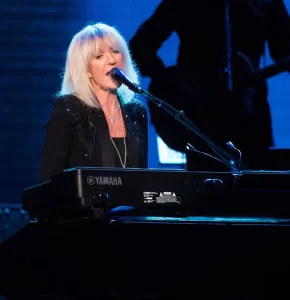
Christine McVie 1943 – 2022:
Like us all, I was so very sad to hear the news on Wednesday of the passing of Christine McVie aged 79. As John Lennon once sang – you don’t know what you got until you lose it…and today I am still reeling from this loss…
Always loved this opening track from the Tusk album where Christine sings so sweetly…
…………………………………………………………………………………………………………………………………………………………………………………………………..
It was 42 years ago …they could not continue as they were…
42 years ago this week I vividly remember taking a call from the Musician’s Only paper and being asked for a quote – these were sad times indeed – and it was about to get worse. The whole ‘Zep to split’ story would get buried somewhat when just four days later John Lennon was shot dead in New York…
Looking back at my diary entry for 42 years ago this very day it started off as a fairly ordinary Thursday.
The night before I’d been to see Rod Stewart at Wembley Arena.
Next morning December 4 1980, The postman woke me up as I shrugged off the inevitable hangover bringing an LP size package containing the latest Zep bootleg Flying High requirement – an excellent recording of the Fillmore West April 27th 1969 date.
Later I phoned Swan Song and spoke to Sian for a while though there was seemingly no major news. I then took some of the freshly printed TBL 5’s round to the post office to send off.
Around 4.30pm a story on Radio One’s Newsbeat stopped in my tracks. It announced Led Zeppelin had released made a statement to the effect that they could not continue as they were.
After Bonzo’s death It was pretty evident that they would be splitting – I’d been in Swan Song a few weeks back and the atmosphere was one of complete loss, but hearing they had officially announced something was still a major shock.
I immediately phoned Sian at Swan Song but she was making no comment.
The diary says ‘’Fuck sake it’s over…’’
The last thing I wrote in my diary that night was equally dramatic.
‘’Part of me died tonight’’
The next week the ‘Zep to split’ news story was buried somewhat under the barrage of press for John Lennon’s tragic murder which occurred on December 8.
These were strange days indeed.
They indeed could not continue as they were…but the legacy could and of course still does…
Since that fateful day of 42 years ago, so much has gone but so much remains and Led Zeppelin are very much in the present tense in all our lives every single day…
Dave Lewis – December 1 2022
TBL ARCHIVE SPECIAL: CODA 40 YEARS GONE:
November 23 heralded another key Zep anniversary as it was all of 40 years ago that the final Led Zeppelin studio album was released. Here’s a ”Then and now” summary of my thoughts on the release of the original album and the expansive reissue:
My Coda Then:
Phone calls, a meeting, the mock up sleeve, a retail competition, raffle and romance…
It was a Monday night – February 22, 1982 to be precise – when my phone rang in my bedroom. ”Hi Dave, this is Robert Plant – we’d like you to bring in some photos for a project we are doing… ”
So began the Coda saga.
Since the release of their In Through The Out Door album, for me personally, many things had happened. The TBL magazine had established itself from a crudely written and printed A5 format into an A4 glossy proper typeset magazine. There was the absolute high of having close proximity on the Over Europe tour in 1980 to the absolute low of the devastating news of September 25th and the statement that signalled it was over on December 4. I still regularly went into the Swan Song office but it had a very strange vibe. Nobody quite knew what to do.
In 1981, Robert began picking up the pieces with a return to the stage in the ad hoc band The Honeydrippers. I attended a fair few of those spring ’81 gigs and it was a great thrill to see him enjoying himself again. TBL issue 6 came out in the August but to be honest, by then my heart wasn’t really in it as it once had been. Without the buzz of the band itself and with their reputation at an all time low, it was difficult to maintain the enthusiasm. It may be hard to believe now but admitting to liking Led Zep was very unhip around these times. The musical climate had moved on, the new wave of British Heavy metal was flowering and elsewhere, electronic music from acts such New Order, Human League, OMD, Gary Numan etc was dominating the charts.
After issue 6, there was no big final decision not to do another issue – it just never happened. I was certainly no less a fervent fan – my energies at that time went into producing the best of TBL project, which became my first book, The Final Acclaim, published in late 1983.
I was aware that there was some unreleased material in the Zep archive, notably the tracks they did not use, recorded at Polar Studios for In Through The Out Door. Jimmy had mentioned this to me in Swan Song on September 18, 1980. I had no idea though, that there was a plan to release them.
Back to the phone call. It was with some shock and awe (this was not an everyday occurrence by any means!) that I took that February call from Robert. Basically, he wanted me to collate as many photos as I had of the group offstage for a project they were looking at. He did not mention at that point about an album. He asked if I was available to come into the Swan Song office that week and of course I replied I was. He made some arrangements and then called me back a couple of hours later to confirm that Thursday would be a good time to come in and meet with him and possibly Jimmy.
So it was, armed with a case full of cuttings and photos, I turned up on the afternoon of Thursday, February 24 at the Swan Song office. A buoyant Robert greeted me warmly and we got down to wading through the stuff. Jimmy duly arrived about 4pm. At one point, seeing a shot he liked backstage at Knebworth, Robert asked me who took the shot. When I replied Neal Preston, he was immediately on the phone to the US office of Swan Song to get his number. He then promptly called Neal to ask him to send over a batch of contact sheets. Robert also called John Paul Jones while I was there.
During all this, it was explained exactly what all this was about. They were going to release a final album made up of unreleased tracks. The sleeve design was to include a collage of off stage photos – hence the reason I was asked to bring in the pics. During the meeting – which also included Robert’s soundman, Benji Lefevre – I heard them discuss a track titled Walters Walk. Jimmy also told me they were considering calling the album Early Days and Latter Days. Ultimately, they went for Coda, though that original title would be deployed for the 1999 and 2000 compilation albums.
Robert also informed me he had completed work on his first solo album and in his words it was ‘’A new step forward.’’ Robert and Jimmy waded through my pics and cuttings and pulled a few out (the Bath Festival backstage pic I showed them made the final cut) and then they were off in search of rare rockabilly records in Camden. It was another afternoon for the memoirs…
Things went quiet on the project after that meeting. I did pop in to Swan Song a few times over the next few months but no news of a release for the intended album was forthcoming. The summer was taken up with the release of Robert’s debut Pictures At Eleven, and I also attended the Princes Trust charity gig at London’s Dominion Theatre, where Robert performed Worse Than Detroit. Tom and I attended the aftershow reception at which all the artists were duly acknowledged for their contributions and we were introduced to Prince Charles. Yet another very memorable occasion.
The next I heard about the Coda album was in October when the Warner Records sales rep came in to WH Smith with the full details of the album, ready to sell it in for a November release. The mock up presenter sleeve the rep carried (and later gave me, see pic above) listed the track details and promotional campaign. It was all beginning to get a little bit exciting.
I ordered 100 copies for the shop and also booked a full in store display. I was also able to acquire a batch of posters from Swan Song which were part of a raffle prize I concocted for the store in conjunction with the local newspaper. Gary Foy was one of the winners, though I did not know him at the time!
The in store display looked fantastic and I wish I had taken a photo of that at the time.
Tuesday November 22, 1982. A grey November morning, and the day Coda emerged into our lives. It was also just around the time the good lady Janet and I first got together – oh yes – couple fell in love to the plaintive strains of We’re Gonna Groove. It may not have been quite like that but when I invested in every conceivable format of said album (LP, cassette, US LP, white label promo) I think Janet had an indication of how things might be ahead when it came to such matters!
I also have a copy of the album signed by Hipgnosis designer, Aubrey Powell when he came here to film some of my memorabilia for a Robert Plant video in early 2005. As he put it, ‘The End,’ or at least the end of another beginning.
In stark contrast to the way it has been with the recent reissues, the Coda album seeped out with little fanfare. As I said earlier, the fact is (mad as it now sounds) at that point Led Zeppelin were hardly held in reverential terms. Their influence would of course become evident in the years to come. It did enjoy some good reviews and entered the chart at number 4 but compared to past glories, it had a definite feeling of unfinished business. That grey melancholy front cover seemed to mirror the whole mood back then. Whilst the release of those eight cuts did spell something of a closure on the story for now, it was all a little low key.
1983 would be dominated by the return to active duty of Robert Plant with the Principal of Moments album and tour, and thus Coda was consigned to the Zep catalogue as the final part of the recorded story for now. Ahead of course, would be the re grouping at Live Aid that put them right back in the spotlight and then the Remasters 1990 releases that would seal their rejuvenation. By then for me, I was right back on it all with the writing and collating of the A Celebration book and the return in 1992 of the TBL magazine. It’s been ever onward since then…
As for the contents of the original album there is much to enjoy and at the time it seemed like a bona fide collectors item – something rare and unreleased to cherish. The whole of side one is an absolute joy, moving from 1970 to 1972. On side two the Polar material is pure fun and the John Bonham tribute was a testament to what had been lost. If I had a complaint, it was the short running time – we now know Sugar Mama was dropped in the final selection.
My Coda Now:
The original album itself sounds as impressive as ever – the vinyl pressing sparkling and full of vitality. It may be short in length but for me it’s long on quality.
The real fun with this reissue is of course the Companion Audio Discs. Jimmy has used this platform to create what he has described as a celebration of the band’s career and music, and as it zips across the years, that is
exactly how it sounds. In doing so it sparks many a Zep memory. This in effect is a Boxed Set 3, packed full of Zep idiosyncrasies.
Commencing with We’re Gonna Groove (Alternate Mix). This is an utterly awesome mix – the live drums and vocals from the Royal Albert Hall ’70 gig/show? now clearly applied. In between the Sol ’82 overdubs, the original live solo can be heard to greater effect. Additional Plant shout at 1 min 35 and Bonzo’s drums sounding incredible throughout. Alongside the rough mix take of In The Evening I would state that this version is the one they should have gone for on the official 1982 line up. It’s the definitive version – simple as.
If It Keeps On Raining When The Levee Breaks (Rough Mix) is yet another key revelation. I was expecting perhaps one of the other bootleg mixes that have seeped out over the years. How wrong could I be? This is a simply invigorating initial run through from November 1970 with a totally alternate laid back swampy feel, slightly faster in tempo to the original. Robert’s vocals have a sparse, low register, echoed scat singing element to them, adding to the almost soundcheck run through quality of the piece. It certainly has a total groove of its own, with pummelling bass line from JPJ, and Bonzo’s drumming as funky as hell, with a distinctive snare drum sound. It fades slightly and then reappears with Robert moaning a muted ‘’Going home’’ refrain. In fact, this fades far too early. You really want it to go on and on, such is the delightful jam like quality of it all. Phew! One of the key finds of the entire reissue programme.
The mix of Bonzo’s Montreux (Mix Construction In Progress) places the syn drums further upfront in a punchier mix. The hi-hat is very clear towards the finale. Less effects on the treated parts. A shout from Bonzo at the close. This is the art of the drummer as master percussionist… always welcome
Baby Come On Home was first released on Box Set 2 and the subsequent package of Coda in the Complete Studio Sessions box set. A lovely relaxed bluesy strut from the beginning of their time.
Sugar Mama (Mix) is a thrilling slice of embryonic Zep from October 3, 1968. Plant’s excited yelp setting the pace. Plenty of echoes of The Yardirds here, with the 1966 single Happenings Ten Years Time Ago a definite reference point. Slightly different to the version that surfaced in lo-fi quality on bootleg in the early 90s, this has an extra ‘Sugar Mama’ from Robert at 32 seconds. Marvel at the innocence and first time energetic blast of the embryonic early Zep…
Poor Tom (Instrumental Mix) is the previously bootlegged instrumental take that highlights John Bonham’s simply sensational New Orleans shuffle throughout. Bluesy acoustic overtones from Jimmy and the harmonica is in there at 1 min 38. Another opportunity to attend a John Bonham masterclass…
Travelling Riverside Blues (BBC Session) was first released on the first 1990 Remasters box set and the subsequent package of Coda in the Complete Studio Sessions box set plus the 1997 BBC Sessions set. It’s a welcome bottleneck affected swooping delight…
Hey, Hey, What Can I Do is another underrated beauty. As first, released as the B side to the US Immigrant Song single in late 1970. In the UK it initially appeared on the 1972 New Age Of Atlantic LP plus the first 1990 Remasters box set and the subsequent package of Coda in the Complete Studio Sessions box set. Light and shady, warm and friendly – joyous from beginning to end…
Companion Disc 2 kicks off with the much bootlegged and talked about Bombay sessions tracks.
Four Hands (Four Sticks – Bombay Orchestra) opens with a count in from an orchestra member. The stereo separation and precise quality is another revelation. Tabla drums and flute combine to add a suitably atmospheric quality to this unique instrumental version, cut in early 1972. A vivid example of their pioneering quest to push the musical envelope wherever it might take them.
On Friends (Bombay Orchestra) the stereo separation is again well in evidence. Robert’s vocals are crystal clear. The mystical vocal moanings, mixed with the ethnic rhythms, makes for an eerie and compelling listening experience.
The much rumoured to exist St. Tristan’s Sword (Rough Mix) turns out to be a three way instrumental work out from 1970 and is built around a totally invigorating bass and drum pattern – the bass and drum syncopation between JPJ and Bonzo is just outstanding. Bonzo putting to good use his best New Orleans shuffle, a la Poor Tom. Enter Jimmy for a Hendrix like feast, not unlike his rampant playing on Jennings Farm Blues. At 2 mins 18 it all breezes off in another direction with a clipped guitar effect, as it chugs on with yet more scintillating Page runs in the Jennings Farm Blues tradition. There’s also a bridge part that would later be employed on Over The Hills And Far Away. Like the instrumental La La on the Zep II companion disc, it’s hard to assess where this piece was going. Was it a warming up in the studio flexing of the musical muscle or a backing track being honed for the addition of Plant lyrics and vocals? It strikes me as being something of an initial pool of ideas – a Led Zep studio brain storm to see what they had and could build on. Whatever it was destined for, it’s a splendid example of them having a blow – and what a blow this is.
Desire (The Wanton Song Rough Mix) has some hoarse alternate vocals from Robert – overall a different texture to the original, with less Leslie effects on guitar break. Playful and less rigid in structure – mainly guitar driven, though the clavinet can be heard rumbling in there. Robert’s last vocal cry is slightly extended. Different take to the bootlegged alternate take aired on the WPLJ radio station in 1975 with far superior vocal.
Bring It On Home (Rough Mix) 2.32. It’s back to one of those on the run sessions that made Led Zep II such a lively concoction. It’s straight into the riff part with Robert’s wailing harmonica – and then very much a live vocal with the singer freely expressing himself with complete abandonment – as he was doing nightly on stage in the US at the time. An excited ‘’Alright!’’ at 1 min 14. Bonzo tearing along with it all as the harmonica comes back in. Totally wild and chaotic, with an electric ending. Superb snapshot of their on the road, ad hoc studio recording, this is Led Zep unleashed in the studio with all the intensity of their mid 1969 barnstorming live performances. Simply blistering…
Walter’s Walk (Rough Mix) is a brash instrumental take – the jittery riffing exercise that would later be applied to Hots On For Nowhere is very apparent. It’s a great moment when the riff bursts in at 2 mins 20 – in fact, with Walter’s Walk it’s all about the riff, as you know.
Finally, Everybody Makes It Through (In The Light Rough Mix) Opens with the familiar drone of the original. What we have here is a mix that features the early ‘’Sunshine brings laughter’’ lyrics of the version on the Physical Graffiti companion disc, matched to Jonesy’s drone links – the Elizabethan intro keyboard part having been replaced. At 1 min 42 Jonesy applies an additional keyboard motif going into the chorus parts. No overdubs on the close. Another work in progress snapshot of one of their finest creations…
Summary: So, there it all is – a unique presentation collection that mirrors every facet of the Led Zeppelin cannon, and a fitting end to this reissue programme.
Conclusion:
I’ll paraphrase what I said at the beginning of the reissue programme. We all recall where we first heard these releases – and where we first purchased them. We have loved and cherished these albums for years and years. They really are like old very reliable friends. Rediscovering them again, in this new context, has inspired us all to fall in love with them all over again. It really has been like a renewal of our Zeppelin vows.
This music developed and presented by Led Zeppelin – be it the original albums or the companion discs – sounds as fresh and vital today as it did when it was recorded some four decades ago. There’s something uniquely eternal about these recordings that, in our minds at least, keeps us forever young.
Dave Lewis
TBL Archive Special:
Led Zeppelin IV – 51 years gone…part 3:
To mark the 51st anniversary of the release of Led Zeppelin IV here’s a TBL archive feature – first compiled for TBL issue 15 though not used at the time – it eventually appeared in the my Celebration II – The Tight But Loose Files book. Here’s part 3 -the final extract…
The Making Of Led Zeppelin IV:
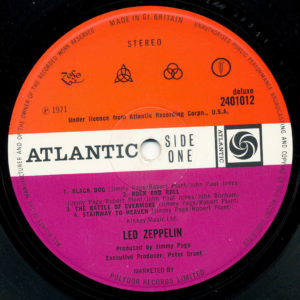 The four symbols that would form the album title were first introduced to the rock media via a series of teaser press ads in the weeks leading to the album’s release, each depicting a particular symbol alongside a previous Zep album sleeve. When the album was released, the wordless title caused much confusion. It appeared in the press under various names including The New Led Zeppelin album, Led Zeppelin IV, Four Symbols, Runes and even Zoso; though some music papers did make the effort to reproduce the actual symbols themselves.
The four symbols that would form the album title were first introduced to the rock media via a series of teaser press ads in the weeks leading to the album’s release, each depicting a particular symbol alongside a previous Zep album sleeve. When the album was released, the wordless title caused much confusion. It appeared in the press under various names including The New Led Zeppelin album, Led Zeppelin IV, Four Symbols, Runes and even Zoso; though some music papers did make the effort to reproduce the actual symbols themselves.
The band’s hectic schedule of that year continued unabated. In August they were back in America for their seventh US tour. Page was in buoyant mood and playing brilliantly. “Once the album was completed and mixed I knew it was really good,” he said. “We actually went on the road in America before the manufacturing process was completed and somebody at Atlantic Records said, ‘This is professional suicide for a band to tour without an album.’ In retrospect that is rather amusing!”
The new material was already making an impact, and Page still recalls with pride the reaction they got to Stairway when they performed it at the Los Angeles Forum for the first time. “We played Stairway’ at the Forum before the album was out and around a third of the audience stood up and gave us a standing ovation. It was then that I thought ‘actually this may be a better number than I’d imagined’.”
Equally successful was a three-city, five-concert first visit to Japan. Here they performed some of the most enjoyable concerts of their career – away from the glare of the press and the intensity of America, they were able to stretch out and extend their set list, throwing in off-the-cuff versions of Smoke Gets In Your Eyes, Cliff Richards’ Bachelor Boy and The Beatles’ Please Please Me and the only logged love performance of Zep III;s Friends. It’s fair to say there were now two distinct entities to the group – the tight recorded unit as found on record and the improvisational and spontaneous live act that would go on to delight audiences around the globe.
After a short break, to round off a very productive year, Peter Grant booked a 16-date UK tour that nicely coincided with the eventual release of their long delayed, long awaited fourth album. The tour kicked off in Newcastle on 11 November and took in two memorable nights at London’s Wembley Empire Pool.
Despite the delays and the negative reaction to the previous album, it was clear that the band’s popularity had not declined at all. Demand for tickets was overwhelming. All 9,000 seats for their 20 November Empire Pool show sold out in under an hour. A second was added and they could have easily slotted in a third had their schedule allowed it.
Their stage presentation now featured each of their four symbols – on Bonham’s bass drum Jonesy’s organ, Jimmy’s speaker cabinets, and Plant’s feather symbol adorning the PA. Page also took to wearing a specially knitted jumper depicting his Zoso symbol. The set list now included Rock And Roll in the main set (now under its correct title), alongside Black Dog, Stairway and Going To California.
Talking about the album to Chris Welch of Melody Maker, Bonzo was hugely enthusiastic: “My personal view is that it’s the best thing we’ve ever done. It’s the next stage we were at the time of recording. The playing is some of the best we have done and Jimmy is like… mint!”
The culmination of the whole year’s efforts were the two significant five-hour shows in London’s Empire Pool on 20 and 21 November – the largest indoor UK audiences they had played to at that point. Dubbed Electric Magic, they were supported by Maggie Bell’s Stone The Crows plus Bronco on Saturday (whose line-up included future Plant solo era guitarist Robbie Blunt and original Band Of Joy member Kevyn Gammond), and Home on Sunday. Also, on both nights, Grant had booked some novelty circus acts, including performing pigs and plate spinners. The pigs – with huge ruffs around their necks – didn’t really cut it; indeed, their only real contribution was an unpleasant smell in the stage area. Thankfully Zeppelin fared better.
‘’It was an amazing couple of shows’’ recalls Maggie Bell, lead singer of Stone The Crows (co-managed by Peter Grant). ‘’ They were the biggest dates we had played and we went down a storm. Those were great shows for us and it was at a point where we were really taking off, and obviously it was a privilege to share the stage with them all.’’
Sadly, Crows guitarist Leslie Harvey died the following May in an electrocution accident at a gig in Swansea. Maggie would later sign to Zep’s Swan Song label.
Roy Hollingworth Of Melody Maker was unstinting in his praise for the Wembley Saturday show: “This was an English band playing like crazy and enjoying every minute of it. They played just about everything they’ve ever written. Nothing – just nothing was spared. This was no job. This was no gig. It was an event for all.”
A memorable poster was produced for the event and sold for 30p – it now changes hands for over £1,000 on the collectors market – and the newly established Virgin Records set up stalls to sell the just-released fourth album. Here and around the country, much to Atlantic’s relief, fans had no trouble identifying the nameless artwork of the new record as it sailed to the number one album spot.
After the disappointing press reaction to their third album, Led Zeppelin IV was very well received. Even Rolling Stone, never a great supporter of the band’s work, relented. The review by Lenny Kaye, then would be rock journalist and future Patti Smith guitarist, was surprisingly positive. “Out of eight cuts,” wrote Kaye, “there isn’t one that steps on another’s toes, that tries to do too much at once. And [there are] a couple of songs that when all is said and done, will probably be right up there in the gold-starred hierarchy of put ’em on and play ’em again. Describing one of those tracks, When the Levee Breaks, Kaye added “Led Zep have had a lot of imitators over the past few years, but it takes cuts like this to show that most of them have only picked up the style, lacking any real knowledge of the meat underneath.”
Led Zeppelin IV climbed to the number one spot on the UK chart on 4 December 1971, where it stayed for two weeks before being dislodged by Electric Warrior by T Rex… it went on to spend 61 consecutive weeks on the chart.
It was a similar story in America, though it was with some irony that Carole King’s multi-million selling soft rock album Tapestry kept it from reaching number one.
Not that it really mattered – the airplay generated by Stairway To Heaven ensured the album remained in the Billboard top forty album chart for the next six months. Peter Grant steadfastly refused to issue the track as a single, knowing that restricting its availability to the LP alone would inevitably add to its sales.
So from the adversity of the Led Zeppelin III backlash, Zeppelin triumphed.
Some four decades on its influence is still paramount, not least with the three ex-members. Over the years, the three ex-members have repeatedly retuned to the songs. Page and Plant attempted an ambitious remake of The Battle Of Evermore with Indian singer Najma Akhtar on their initial MTV Unledded reunion and also performed versions of When The Levee Breaks and Four Sticks. Robert Plant was still regularly performing Black Dog, Rock And Roll, and Misty Mountain Hop on his Band of Joy tour this year – the latter was also revived when Page linked up for his much acclaimed tour with The Black Crowes. On his solo tours, John Paul Jones has performed instrumental versions of Black Dog and When The Levee Breaks.
As a complete work, Led Zeppelin IV remains their most focused statement.
It’s the product of a band on a quest for absolute musical freedom. Working in an environment that encouraged the development of their ability to blend acoustic and electric influences within a rock framework – something Led Zeppelin did more successfully than any other act before or since.
The eight cuts possess an economy and subtly that defines their sound. From Page’s unimpeachable riffs, through Jones’ musical invention, Plant’s clarity of vocal to that titanic John Bonham drum sound – Led Zeppelin IV still emits a freshness that belies its age.
Dave Lewis -December 1 2022
—————————————————————————————————————————————————————-
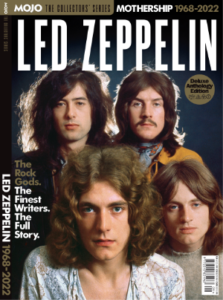
Mojo Collector Series – Led Zeppelin Mothership 1968 – 2022:
https://www.mojo4music.com/articles/stories/mojos-new-led-zeppelin-special-is-out-now/
Dave Lewis -November 29 2022
—————————————————————————————————————————————————————
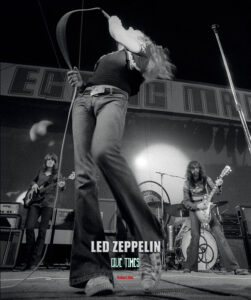
https://www.therocklibrary.com/index_book_ledzeppelin.php6
DL Diary Blog Update:
Friday November 25:
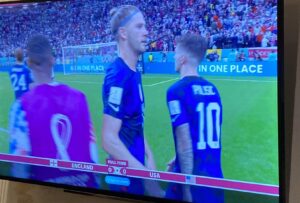
Not a great performance but still top of the group…
Saturday November 26:
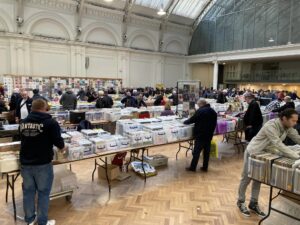
Saturday is platterday and there are plenty at the VIP record fair in Victoria London- LP records 45 rpm singles and CDs are being purchased!
Sunday November 27:
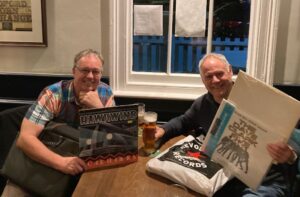
With my record collecting comrade Steve yesterday in The Fox and Hounds wading through our acquisitions from the excellent London VIP Victoria Fair earlier…and yes that’s another Beatles White Album I am holding up – this one a Capitol label reissue with inserts – you can never have too many copies of the 30 track 1968 masterpiece…
Monday November 28:
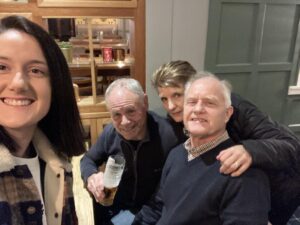
Great to meet up with my life long friend Dave Corp and his wife Jane and daughter Victoria tonight…
Tuesday November 29:
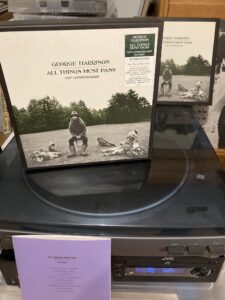
Remembering George…21 years gone…
Tuesday November 29:
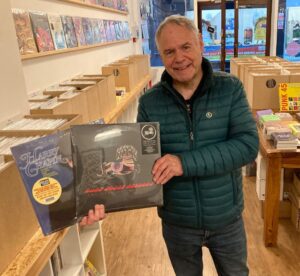
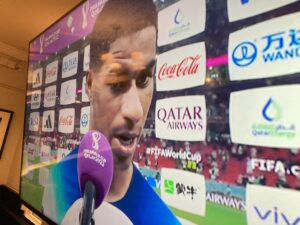
Update here:
A busy and often challenging week and now December is here and there will be a lot going on including planned publication of the Five Glorious Nights revised and expanded edition – more on that soon. Good to see England make it to the round of 16 and now it’s Senagal on Sunday – here’s hoping they can play to their potential…
Thanks for listening
Until next time…
Dave Lewis – December 1 2022
TBL website updates written and compiled by Dave Lewis
Follow TBL/DL on Facebook:


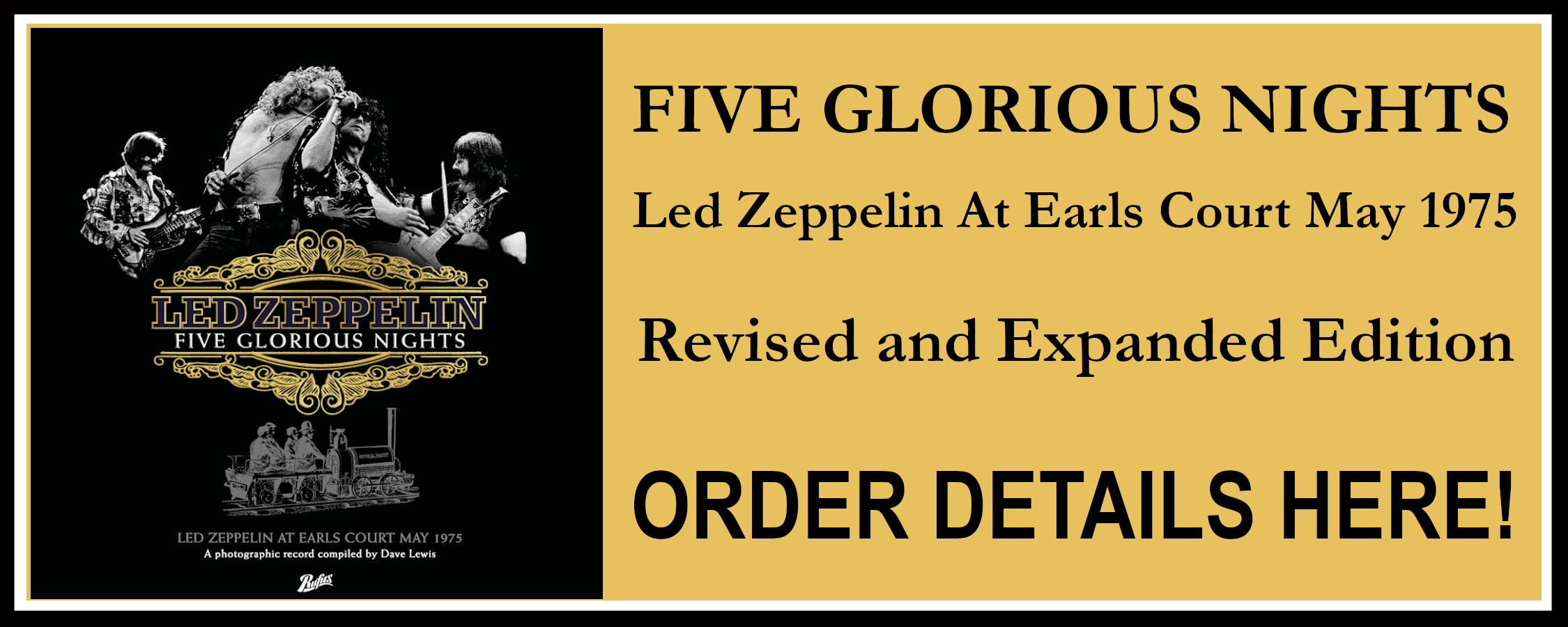


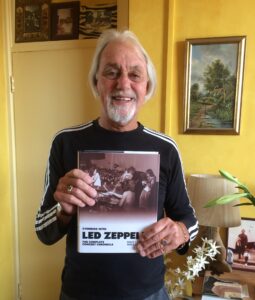
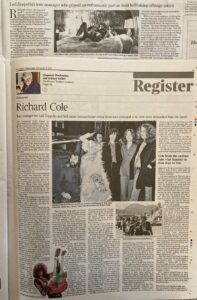
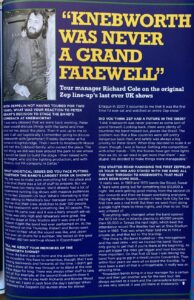
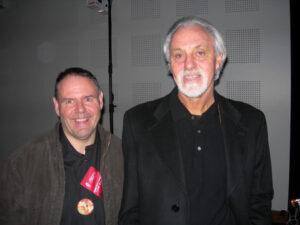
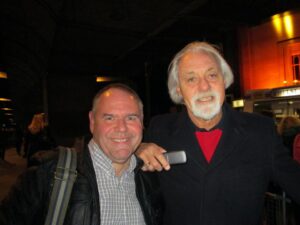
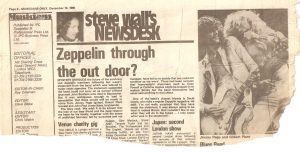
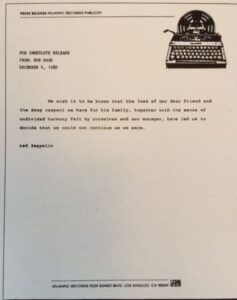
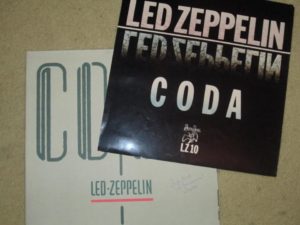
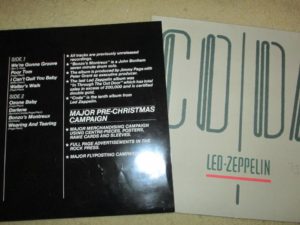
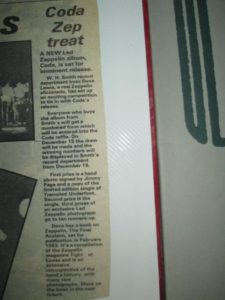
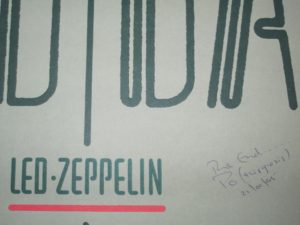
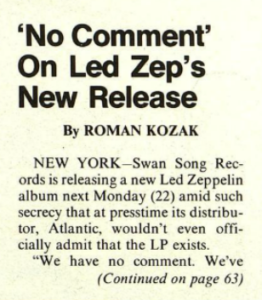

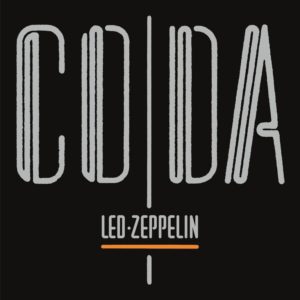









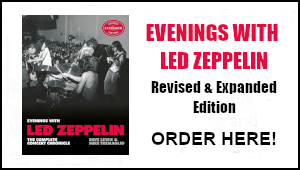
Hello again Dave. Russ forward to me the latest TBL. Great to see another of those pics i took at Heathrow all those years ago. We were so young (i was 19) and didn’t really know what we were doing or where we were going. Now (at 65), i look back and think to myself, i’m really happy that we did what we did, and……i’m so glad i took my camera with me that day……Great Memories !
Leave your response!